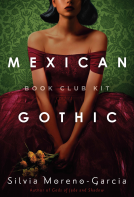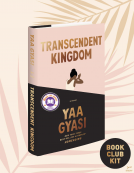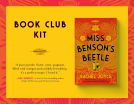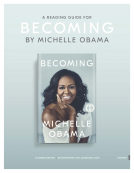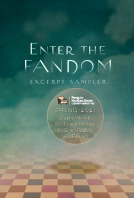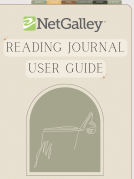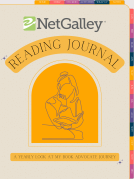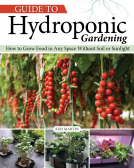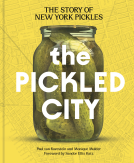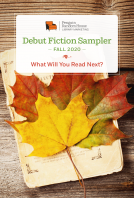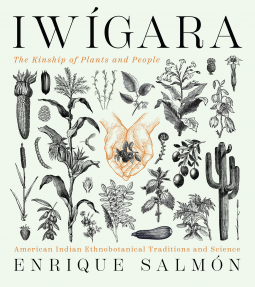
Iwigara
American Indian Ethnobotanical Traditions and Science
by Enrique Salmon
This title was previously available on NetGalley and is now archived.
Send NetGalley books directly to your Kindle or Kindle app
1
To read on a Kindle or Kindle app, please add kindle@netgalley.com as an approved email address to receive files in your Amazon account. Click here for step-by-step instructions.
2
Also find your Kindle email address within your Amazon account, and enter it here.
Pub Date Sep 15 2020 | Archive Date Jan 31 2021
Talking about this book? Use #Iwígara #NetGalley. More hashtag tips!
Description
"A beautiful catalogue of 80 plants, revered by indigenous people for their nourishing, healing, and symbolic properties." —Gardens Illustrated
The belief that all life-forms are interconnected and share the same breath—known in the Rarámuri tribe as iwígara—has resulted in a treasury of knowledge about the natural world, passed down for millennia by native cultures. Ethnobotanist Enrique Salmón builds on this concept of connection and highlights plants revered by North America’s indigenous peoples.
Salmón teaches us the ways plants are used as food and medicine, the details of their identification and harvest, their important health benefits, plus their role in traditional stories and myths. Discover in these pages how the timeless wisdom of iwígara can enhance your own kinship with the natural world.
Available Editions
| EDITION | Other Format |
| ISBN | 9781604698800 |
| PRICE | $35.00 (USD) |
| PAGES | 248 |
Links
Average rating from 39 members
Featured Reviews
 Kaye T, Reviewer
Kaye T, Reviewer
A very interesting read reading the usage and belief systems regarding a lot of plants. For example, looking up milkweed, which is well known as a crucial plant for Monarch Butterflies, that author describes how many Native Americans view the butterfly as the transformation of a dead loved one. To know that you are protecting the habitats of these is to protect the ancestors. A nice point of view. It also describes how to use the plant for human consumption too. The milkweed makes a good tea for excessive mucus, and also can be used as a chewing gum. The stuffing inside the plant can be used for pillows. The latex can be used for skin sores and to remove warts, and the root can be ground into a powder to reduce stomach issues and diarrhea. A lot of information, and this is just for one plant. Details of how to recognize the plant and when the best time to harvest parts is also described. Really enjoyed this book as a reference book. Highly recommend this one, as it is well detailed and organized well. Would be a great addition to anyone's library.
Iwigara is a treasure among nature & outdoor writings. The book’s title refers to the interconnectedness of all lives in the vein of Robin Wall Kimmerer’s philosophy of blending typical empirical science with a deeper sense of knowing. While the writing is not as lyrically poetic as Kimmerer, this book’s author, Enrique Salmon, certainly inspires a deep respect for the natural world of plants.
Sections on each of the 80 plants includes related native mythology or the author’s personal anecdotes, uses across multiple native groups, field identification & harvest info, and some scientific ethnobotanical data along with several color photos. Just enough info to really inspire further study, but brief enough for an accessible introduction that spans many indigenous tribes in all regions of North America. I appreciate the generous inclusion of plants in the Southwest region which can be overlooked in many medicinal and edible plant guides.
This botanical reference is worthy of multiple reads and frequent references. It’s ideal for those interested in foraging, indigenous culture, or North American ethnobotany with a spiritual flavor.
I believe it is our duty to protect the environment and to hopefully make the world a better place, when possible. I love books about nature, because I want to gain a better understanding of our amazing home and how it works. We affect nature, we are nature. We are all connected and I want to understand that relationship, and sustain it when I can. And I really loved this book because it encourages us to do exactly that. The cover art is gorgeous, and the pages are filled with valuable information about American Indian plants and traditions. Tribal religions place importance on the relationship with nature, and I think that we could all benefit by incorporating that into our daily lives more. This book helps us to do that by breaking down the meaning and use of familiar fruits, herbs and flowers and teaches us the medicinal benefits of each plant. This book is perfect for nature lovers and health lovers!
 Heather H, Librarian
Heather H, Librarian
This is a beautiful book with great information, gorgeous pictures, and thoughtfully written. I will be revisiting it to learn more about the native plants growing in my region.
 Margaret E, Librarian
Margaret E, Librarian
The author explores 80 plants found across the US and provides the reader a brief, tempting taste of each describing uses, ID/harvest, health and including beautiful photos to help identify. A preface discusses regions of the US. The main portion of the book lists the plants alphabetically. There is a comprehensive index and further reading sections.
This book is not one to be read straight through, but explored. As I was paging through, I wished for lists by region as I found I wanted to focus on plants from my region or even adjacent regions. I also wished for a comprehensive booklet on each of the plants - so I could collect the booklets of plants on our property.
I really enjoyed this book as my understanding of nature and our relationship "kinship" is enhanced. This book will be welcome on my bookshelves and frequently referenced.
Digital copy provided by NetGalley. Thank you!
 Amy M, Librarian
Amy M, Librarian
I first heard about Iwigara by Enrique Salmon at PLA in Nashville this past February. I've been eagerly waiting to see a copy since then. This book is full of botanical uses from Native Americans in North America. The uses range from material to edible, to medicinal. I love to learn about this and find plants and trees that are native to my area of the country where the Shawnee Indians lived and traveled along the Ohio River in Southwest to Southcentral Ohio. It's important to know this information and I'm glad the book will soon be available.
This was a fascinating read. A lot of. Interesting uses for some very common plants, maybe I can survive in the forest.
 Librarian 22381
Librarian 22381
The author, and ethnobotanist, tells about plants used by Native Americans. Each plant is introduced by family, parts used, season, and region. There are numerous excellent illustrations to aid in identification, and it is surprising how many familiar plants were used not only as food, but also medicinally to promote good health. Thanks to the publisher and to Netgalley for providing me with an advance copy in exchange for an honest review.
 Mack P, Reviewer
Mack P, Reviewer
Iwígara is a fascinating look into North American ethnobotany.
What makes this book outstanding is how accessible it is, you do not need to know much about ethnobotany or plants in general to appreciate this book. You might find some scientific names, but a glossary explains what could be unfamiliar to the layperson. Additionally, a simple but beautiful layout, pictures and easy to understand text make Iwígara easy on the eyes and a joy to read.
Enrique Salmón does a great job introducing laypeople to the Native plant knowledge of North America, without dumbing it down. At the same time I imagine that this book is also a joy to read for more experienced ethnobotanists (I cannot tell, my knowledge of ethnobotany is limited to one or two books besides this one).
I recommend this wholeheartedly for anyone who wants to know about plants and Native knowledge, whether they are from North America or not.
 Geraldine M, Media/Journalist
Geraldine M, Media/Journalist
Wonderful reference! I look forward to using in my roles as a program specialist at a Native American site and as a writer.
 Jacqui H, Librarian
Jacqui H, Librarian
A beautiful resources for the indigenous history and uses of plants. The short introduction of each geographical area and the indigenous inhabitants coupled with the alphabetical list of plants is informative, delightful and important. Highly recommend.
 Allison R, Librarian
Allison R, Librarian
I think that this book would be a great entry in a library with a collection focused on indigenous knowledge and/or botany/ethnobotany. I found it fascinating, well-written, and well-researched. Unfortunately I don't think it would find much of an audience in my library. It would be better suited to a larger public library or an academic library. I really enjoyed it though and I'd consider purchasing myself a finished print copy.
A unique and fascinating look at the history of and use of native North American plants by Native American tribes. Beautiful photos help in identification, a thorough glossary of terms, and interesting personal stories all make this guide a must add to the collection of anyone interested in medicinal uses of native plants and their historical use. The inclusion of many native origin stories added interest to the book and drew me in early on.
Iwigara is a fascinating resource about the origins, benefits, and uses of plants across North America. One of the greatest strengths of this collection is how Salmon blends Native American traditions, myths, and cultures with the scientific credibility of his ethnobotany/biology background. It's the perfect blend of scientific research-based fact combined with the evidence-based knowledge and skill passed down through years of tradition and firsthand practice. It's a beautiful pairing that makes the content in this book even more interesting and understandable.
Another great strength of this collection is how approachable Salmon makes it. Everything is explained thoroughly, but with the gentleness and patience of someone who truly cares for their craft and eagerly wants the reader to absorb and understand everything. He never talks down to the reader or veers into jargon that will leave the everyman behind. Instead he provides concise but thorough information using the clearest language possible. For situations where advanced language is required, there are handy guides at the back of the book to help steer the way.
As a resource, this book does an excellent job explaining everything a reader could want to know about plants (but without diving too deep). Each entry describes the origins and current standings of the plant - where it can be found, when it grows, how it grows. The usefulness and benefits behind each plant is examined - everything from health benefits, to medicinal uses, to hygiene, to lifestyle applications. Most also come with a story of sorts woven in, whether about how this plant plays a role in Native tradition and culture or in the form of a small story from the author's own life and personal experiences with it. It's simultaneously charming and informative which is a great combination for a nonfiction resource that could feel daunting otherwise. As a reader I was surprised that the entries don't detail how to use the plants, just what they can be used for. So if you are looking for something purely instructional, this may not be the guide for you.
Great resource providing loads of great facts, cultural insights, and way more heart than most botanical books could rightfully claim. Definitely worth picking up.
Special thanks to NetGalley and Timber Press for an eARC in exchange for an honest review.
 Librarian 431790
Librarian 431790
What a fascinating and informative book! It made me think and I learned a lot about Native Americans traditions.
I loved the gorgeous illustrations and how well the different plant usage and traditions are explained.
It's an excellent read that I strongly recommend.
Many thanks to the publisher and Netgalley for this ARC, all opinions are mine.
 Kat H, Reviewer
Kat H, Reviewer
As a gardener and lover of all things plants, I found this book to be fascinating. Often, when reading about plants used by Native Americans, there is a simplistic mention that usually falls in to the categories of medicinal (frequently - causes diarrhea or good for constipation = which I always find amusing, but not helpful.) Salmon’s research and descriptions made for detailed and enlightening descriptions. Well done!
5 Stars. Thank you to NetGalley and the publisher for the eARC of this book.
This will be a really great personal reference book. I loved reading it a few entries at a time, but the real value in this book will be as I return to it over and over again for specific questions or curiosities. Salmon makes entries personal by tying in stories and cultural touchpoints. What a great way to learn more about plants AND the people of this land.
"Iwigara explores 150 plants of key importance to American Indians. Enrique Salmón reveals how the plants were traditionally used, why they were used that way, what their health and medicinal applications and benefits are, and basic scientific data about each plant. An added layer of meaningful context comes via traditional stories and myths the author shares about these plants and images of the plants appearing in different forms of Native American art, craft, and homes."
I love a good reference book on plants! Even more when they include common uses as this one does, it's very practical and has a lot of plants you would find. One plant you will find in here is the Joe Pye weed. Which honestly, I want to rip out of my garden every year, but ultimately am glad I don't as it seems to be a good plant to have. It always seems such a shame that we remove "weeds" that have real benefit to them.
 Reviewer 610591
Reviewer 610591
Iwigara is a truly lovely book. Dr. Enrique Salmón is from the Rarámuri (Tarahumara) tribe of northwestern Mexico and studies ethnobotony and traditional ecological knowledge. Viewing the plants from a traditional indigenous perspective is what makes this book truly special, and not just another guide to planes.
Salmón includes 80 plants, from ash and blueberry to willow and yarrow, and it's the writing in the descriptions that rally shines. Each description includes native myths and stories related to the plant, personal reminiscences, and how different tribes used each plant.
The guiding principle is Iwigara itself, the idea that all living things - plants, animals, humans - are interconnected and share the same breath. As a Unitarian Universalist, this naturally resonated with me, as one of the seven UU principles is "Respect for the interdependent web of all existence of which we are a part." Anyone interested in ethnobotany, Native American teachings, or Ancestral Know.edge, (along with UUs!) will find this an interesting read.
 Educator 293566
Educator 293566
As a reference for the classroom, the students will impressed. They will be able to use along with other reference books on this subject. The photography is well done.
 Librarian 76706
Librarian 76706
Beautifully done exploration of native American traditions and relationship with nature. This Is definitely a must have and a must share with readers.
I was drawn to the cover illustration and unusual title and I had the opportunity to review a digital copy through Netgalley: Iwigara is described as both a story and a reference book; I was looking forward to experiencing a visual treat with historical photographs, plant images, and botanical illustrations of the 80 food and medicinal native plants that were to be covered. Enrique Salmon begins with giving the reader a peek into the worlds and cultures of the indigenous peoples of North America, he then takes you on a quick tour of the plants: how to identify, harvest and prepare, their health benefits and uses, and many include a story or anecdote.
I ordered the hardcover book and was disappointed in its size and presentation. The text was hard to read, had small margins, and the photographs were not inspiring. Much of the art seemed to be clip art or found online. It ended up not living up to my expectations, so I returned it.
I loved the gorgeous mix of science, history and culture that Salmon presented here. The pictures of plants were vibrant and the descriptions were clear and illuminating. I especially liked how the author weaved traditional native stories and added archival photos of indigenous people throughout.
As a Mexican-American woman with native roots, this book made me feel closer to my own background. And as a person who grew up in the Midwest, it was great to be able to learn about the natural world of trees, plants and flowers that have surrounded me my whole life, but I've never knew much about.
I will definitely highlight this book at my library during Native American Heritage Month, but will also promote throughout the year to patrons who are interested in Native culture and history, nature and coffee table books full of beautiful images.
This book remind me of some of my favorite books that also combine Native culture, history, science, and a reverence for the natural world:
Braiding Sweetgrass: Indigenous Wisdom, Scientific Knowledge, and the Teachings of Plants by Robin Wall Kimmerer
Trace: Memory, History, Race and the American Landscape by Lauret Savoy
Medicine Stories: History, Culture and the Politics of Integrity by Aurora Levins Morales
Borderlands/La Frontera: The New Mestiza by Gloria Anzaldua
Decolonize Your Diet: Plant-Based Mexican-American Recipes for Health and Healing by Luz Calvo, Catriona Rueda Esquibel
Iwigara is a layman accessible survey of the ethnobotany of the indigenous peoples of North America and their knowledge and relationships with the plants in their environs. Released 15th Sept 2020 by Workman Publishing on their Timber Press imprint, it's 256 pages and available in hardcover and ebook formats.
This is a very well written, exhaustively researched and annotated layman accessible treatment of ethnobotany in the Americas. I was reading an article a while ago about the loss of oral traditions and how vast and irreplaceable the loss of culture and knowledge could potentially be. One of the most vital links between a people and their environment comes in the form of the knowledge of food and medicinal plants in the local environs. For thousands of years this knowledge has been handed down in families and social groups from one generation to the next in an unbroken line; knowledge which is now perilously close to being broken and lost.
The work of the author and other anthropologists is vital in preserving this information. The format of this book is easy to navigate and understand. A short introduction gives a capsule glimpse into ethobotany and related anthropological research. It's followed directly by a list of relevant plants used by or sacred to (or both) local indigenous people of North America. Each of the entries is listed with common name, botanical (Latin) classification, a description along with uses and identification highlights and a photo. This is an academic collection and not a guide for uses with recipes or anything similar. The book also includes a cross-referenced index, short glossary, and an abbreviated bibliography.
Well done, respectful, and easily accessible volume. This would make a superlative selection for library acquisition or a fine gift for horticulturally interested readers.
Five stars.
Disclosure: I received an ARC at no cost from the author/publisher for review purposes.
"Iwígara - The Kinship of Plants and People", is a book about "American Indian Ethnobotanical Traditions and Science.
There's a lot of research and knowledge poured into this book. There is a little background of all the different areas that were American Indian territory with their origin stories which I found fascinating. We then have an alphabetical collection of plants where there is a plant story, information about how the American Indians used them, how to identify and harvest it, and the health benefits associated.
This is a great collection, there are so many plants included, and I loved seeing the different uses and health benefits which I was not aware of. It's interesting how a society developed this amount of plant knowledge. They depended on plants differently than we do today, and they explored all sorts of abilities. I'll be honest, I've been around the Prickly Pear cactus and I wouldn't have guessed it's edible
 Ashley G, Librarian
Ashley G, Librarian
"Ethnobotany" was a new term for me. Here's the definition: "the scientific study of the traditional knowledge and customs of a people concerning plants and their medical, religious, and other uses." This book discusses how indigenous people and their connection to plants, how they used them, and their role in the natural system of things (the circle of life, for lack of a better term). I really enjoyed this.
 Kelli P, Librarian
Kelli P, Librarian
This is a beautifully put together book. The information is fantastic and easy to read and the images are all beautiful and helpful. I will definitely be looking for a physical copy of this.
 Kim C, Educator
Kim C, Educator
Plants and people have had a relationship for thousands of years, since time immemorial. On this continent, the Native Americans had many plants that they used for a variety of purposes. With the decimation of native cultures a lot of that plant knowledge has been lost. However in this book the author brings together a collection of plants and indicates the native knowledge of these plants for a new audience.
The relationship that the native people had with plants is much different than the modern relationship which is all about using plants as a product. The native people utilized plants in a respectful way and did not take more than they could use. That philosophy is shown in this book and hopefully we can learn from this a new relationship with plants. By being respectful of all plants, we show our appreciation for what we can learn from them and what we can use them for in a sustainable way.
Enrique Salmon has written a wonderful book that tells a modern audience of the historical uses of many of the plants that we can still find in natural areas today. These plants range from cactus to flowers and more, all of which had many uses that modern people may not be familiar with. We may think of many of these plants as weeds. We can't approach the use of plants the same way that we do with crops on a farm. Native plants exist in far fewer numbers than the monoculture crops that we grow on farms. Native plants have to be respected and treated right because they don't grow in any large quantity (like on a farm) and if people were to go out and just start overharvesting them these species would not survive.
What I liked about this book was that the author showed us how to use respectful harvesting methods. Being respectful means thinking about generations yet to come and leaving enough plants there so that there are plants for them to enjoy and use as well. If you take everything, there is nothing left to re-seed. We don't want to overharvest and take every plant as is done on farms because that's not the purpose of native wild plants. Many of these plants had medicinal uses, or were used for food, or were used to make things such as baskets or tools. It’s fascinating to learn how the original people utilized the life around them. Although we may have changed our perceptions and think of some plants as weeds, that’s just because we really don’t know the plants!
Plants don't exist just to feed humans. They have a purpose in nature. Our challenge is to learn what that is. If we are to continue to have a relationship with plants we need to study them closely. For example, what time of year should they be harvested? How do we safely harvest them so as to leave some for future generations? How do we help spread the seeds of those plants so that more of them can grow?
A book like this goes beyond just a field guide. It gives a human history of our relationship with plants. I thoroughly enjoyed it. Five stars.
Readers who liked this book also liked:
Silvia Moreno-Garcia
Historical Fiction, Literary Fiction, Sci Fi & Fantasy
Rachel Joyce
Historical Fiction, Literary Fiction, Women's Fiction
Publishers Lunch
General Fiction (Adult), Nonfiction (Adult), Teens & YA
Brian Soonho Yoon
Children's Nonfiction, Crafts & Hobbies
Sam Morrison
Children's Nonfiction, Crafts & Hobbies, Outdoors & Nature
